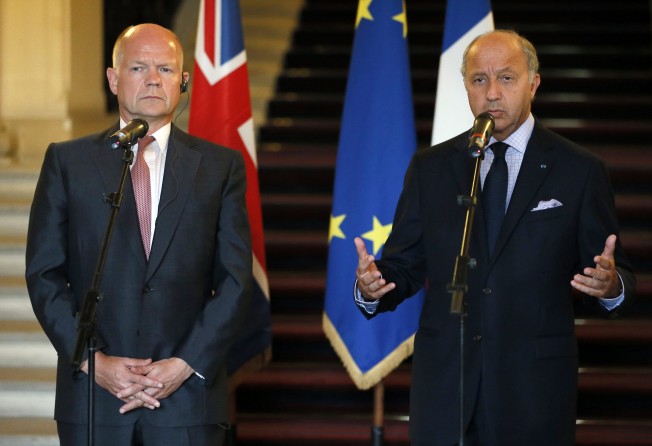France urges use of force if Syria chemical attack proven
Footage shows dozens of fatalities, including women and children, and a large number of the survivors in obvious distress

France's foreign minister yesterday raised the possibility of the international community using force if it is proven that Bashar al-Assad's regime used chemical weapons in an attack the Syrian opposition says killed more than 100 people.
Laurent Fabius spoke a day after the UN Security Council called for "a thorough, impartial and prompt investigation" of the latest allegations against the regime, in a statement that diplomats say was watered down by objections from Russia and China.
Opposition forces and activists have said that at least 136 people, including many children, were killed by toxic gas in the Wednesday attack in which most bodies bore no sign of wounds.
Speaking on RMC radio, Fabius did not make it clear how the use of chemical weapons by the Syrian regime might be proven. But if there was proof of a chemical weapons attack by the regime, "we need a reaction by the international community .... a reaction of force", he said.
The Syrian government has denied using chemical weapons in an artillery barrage targeting suburbs east of Damascus.
Britain stressed the first priority was to verify the facts surrounding the attack, but also hinted at the use of force. "We believe a political solution is the best way to end the bloodshed," said a spokesman from the Foreign Office said. "However, the prime minister and foreign secretary have said many times we cannot rule out any option ... that might save innocent lives in Syria."
The attack coincided with the visit to Syria by a 20-member UN chemical weapons team which has a mandate to only investigate three previous allegations of chemical weapons use. Without a mandate, which needs Syria's approval, the investigators would not be able to visit the site of the attack.
Beijing said UN chemical weapons experts should be objective and fully consult with the Syrian government in their work.
"China's position is very clear. It does not matter what side in Syria uses chemical weapons, China resolutely opposes it," the Foreign Ministry said in China's first public response to the attack.
"At present, the UN's chemical weapons inspection team for Syria is on the ground beginning its investigations, and [China] hopes that the team fully consults with the Syrian government and maintains an objective, impartial and professional stance, to ascertain what really happened."
Syrian government forces pressed on with a military offensive in eastern Damascus yesterday, bombing rebel-held suburbs said to have been targeted by chemical weapons. Experts who examined video footage of the aftermath of the purported gas attack believe it shows the most compelling evidence yet consistent with the use of a lethal toxic agent.
They include analysts who had previously raised questions over the authenticity of previous claims or who had highlighted contradictions.
"The video footage and pictures this time are of a far better quality," said Jean Pascal Zanders, a former analyst with the chemical and biological warfare project at the Stockholm International Peace Research Institute, who has worked in the field of chemical, biological and nuclear proliferation since the mid-1980s and who has questioned some previous claims.
Zanders said: "You can clearly see the typical signs of asphyxiation, including a pinkish blueish tinge to the skin colour. There is one image of an adult woman where you can see the tell-tale blackish mark around her mouth, all of which suggests death from asphyxiation."
Additional reporting by Reuters
Lethal chemical agents
Experts generally recognise seven categories of chemical agents used to disable or kill people.
Choking agents: Injure the nose, throat and lungs. Inhalation causes lungs to bleed, drowning victim. Examples: Chlorine, phosgene gases
Blister agents: Severely burn and blister the skin or respiratory tract. Blister agents can be dispersed as liquid or vapour and can linger for days. Blindness, lung damage and bone-marrow suppression can occur after sub-lethal doses. Examples: Mustard gas, lewisite
Blood agents: Inhibit the ability of blood cells to absorb oxygen, causing suffocation. There are no confirmed reports of these agents ever being used in war. Examples: Cyanide compounds, arsenic compounds
Nerve agents: Enter body through skin or lungs. Rapidly disrupt the transmission of nerve impulses, causing them to continually fire. Muscles, including the heart and those controlling breathing, spasm. Examples: Sarin, tabun, soman
Riot control agents: Eye, skin and respiratory-tract irritants. Can be fatal in concentrated doses. Examples: Tear gas (CS gas or CN gas)
Incapacitants: Cause psychotic disorders, including incapacitation and an inability to make decisions. Examples: LSD, BZ, PCP
Defoliants: Destroy vegetative cover and crops and can cause nerve damage. Examples: Agent orange, paraquat
Washington Post